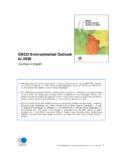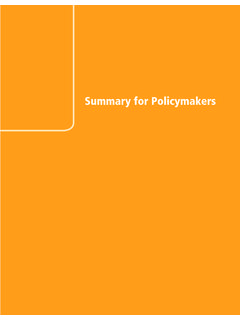Transcription of Improving feed conversion ratio and its impact on reducing ...
1 Improving FEED conversion . ratio AND ITS impact ON. reducing greenhouse GAS. emissions IN aquaculture . Cover photographs: Front cover Top: Feeding of Atlantic salmon (Salmo salar) by automatic feeder, Chile (courtesy of Michael Adler). Middle: Hand feeding of marine shrimps (whiteleg shrimp Litopenaeus vannamei and blue shrimp Penaeus stylirostris). in Ecuador (courtesy of Laurence Massaut). Bottom: A wooden platform with manually operated feeding apparatus in a small family-run striped catfish (Pangasianodon hypophthalmus) farm near Long Xuyen City, An Giang Province, Viet Nam (courtesy of FAO/Mohammad R.)
2 Hasan). Back cover Hand feeding of marine shrimps (whiteleg shrimp Litopenaeus vannamei and blue shrimp Penaeus stylirostris). in Ecuador (courtesy of Laurence Massaut). Cover design: Mohammad R. Hasan and Jose Luis Castilla Civit. Improving FEED conversion . ratio AND ITS impact ON. reducing greenhouse GAS. emissions IN aquaculture . by Mohammad R. Hasan aquaculture Officer aquaculture Branch FAO Fisheries and aquaculture Department Rome, Italy and Doris Soto Senior Researcher Interdisciplinary Center for aquaculture Research INCAR, Concepci n, Chile FOOD AND AGRICULTURE ORGANIZATION OF THE UNITED NATIONS.
3 ROME, 2017. The designations employed and the presentation of material in this information product do not imply the expression of any opinion whatsoever on the part of the Food and Agriculture Organization of the United Nations (FAO) concerning the legal or development status of any country, territory, city or area or of its authorities, or concerning the delimitation of its frontiers or boundaries. The mention of specific companies or products of manufacturers, whether or not these have been patented, does not imply that these have been endorsed or recommended by FAO in preference to others of a similar nature that are not mentioned.
4 The views expressed in this information product are those of the author(s) and do not necessarily reflect the views or policies of FAO. ISBN 978-92-5-109886-8. FAO, 2017. FAO encourages the use, reproduction and dissemination of material in this information product. Except where otherwise indicated, material may be copied, downloaded and printed for private study, research and teaching purposes, or for use in non-commercial products or services, provided that appropriate acknowledgement of FAO as the source and copyright holder is given and that FAO's endorsement of users' views, products or services is not implied in any way.
5 All requests for translation and adaptation rights, and for resale and other commercial use rights should be made via or addressed to FAO information products are available on the FAO website ( ) and can be purchased through This publication has been printed using selected products and processes so as to ensure minimal environmental impact and to promote sustainable forest management. iii Preparation of this document This FAO Non-Serial Publication was prepared under the coordination of Dr. Mohammad R. Hasan of the aquaculture Branch, FAO Fisheries and aquaculture Department.
6 It was compiled, along with a series of presentation available online, as a part of FAO's Strategic Objective (SO2) to: Increase and improve provision of goods and services from Agriculture, Forestry and Fisheries. Specifically, this publication contributes to the organizational outcome 2011. that aims to have: producers and natural resource managers adopt practices that increase and improve the provision of goods and services in agricultural sector production systems in a sustainable manner. The rationale of the work undertaken was to i) assess the current GHG contributions of aquaculture , related to feeds and feeding, and understand ways to measure it.
7 Ii) explore current potential for reducing Feed conversion ratio (FCR) for a range of important and commercially significant species, and therefore continuing to improve their environmental performance including reductions in GHG and iii) explore potential transfer of feed and feeding technologies and lessons learnt from the well-developed salmon farming industry to other freshwater and marine species such as carps, catfishes, tilapia and shrimps. The activity undertaken and publication of this document were partially funded under the auspices of the project Climate change, fisheries and aquaculture : testing a suite of methods for understanding vulnerability, Improving adaptability and enabling mitigation (GCP/GLO/322/NOR) , supported by the Government of Norway, while the FAO/GSI (Global Salmon Initiative) workshop was hosted by Biomar on behalf of GSI with the support of Aquacorporaci n Costa Rica.
8 Preliminary compilation of the workshop report and initial data gathering for the GHG tool was undertaken by Mr Jonathan Moir. The GHG tool was developed by Dr Michael MacLeod, with inputs from several colleagues from FAO and elsewhere. For consistency and conformity, scientific and English common names of fish species were used (FishBase php). Dr. Richard Anthony Corner is acknowledged for general technical editing, Ms. Marianne Guyonnet and Ms. Danielle Rizcallah for their assistance in quality control and FAO house style.
9 Mr. Jose Luis Castilla Civit prepared the layout design for printing. The publishing and distribution of the document were undertaken by FAO, Rome. Finally, Dr. Malcolm Beveridge, Head of the aquaculture Branch of the FAO Fisheries and aquaculture Department is acknowledged for providing the necessary support, advice and insight to complete this publication. iv Abstract This document presents in Section A the narrative report of the outcomes from an FAO/GSI (Global Salmon Initiative) Joint Workshop on reducing Feed conversion Ratios in the Global aquaculture to reduce carbon and other footprints and increase efficiency including conclusion and recommendations.
10 Section B provides summaries of the technical presentations given at the workshop. Section C provides a link to a compendium of the workshop PowerPoint presentations that was presented in the workshop (available online) and Section D summarizes FAO's spreadsheet-based (Excel ) tool for quantifying greenhouse gas emissions arising from aquaculture , with a web- link to be able to download the application. The FAO/GSI Joint Workshop was held in Liberia, Costa Rica from 9 to 11th November 2015. The meeting, convened by FAO and hosted by Biomar on behalf of GSI with the support of Aquacorporaci n Costa Rica, was attended by international experts from Asia, Africa, Europe, North America and South America, representing global areas where carp, catfish, tilapia, marine shrimp and salmon farming are undertaken.

















